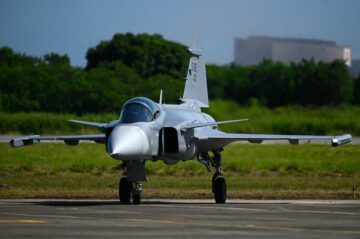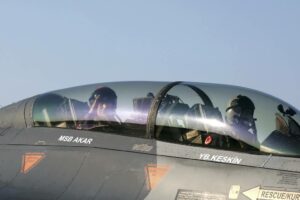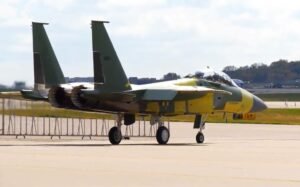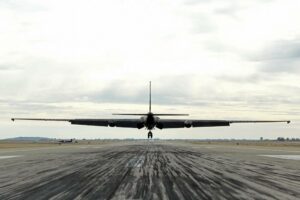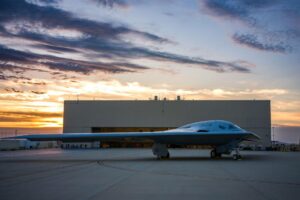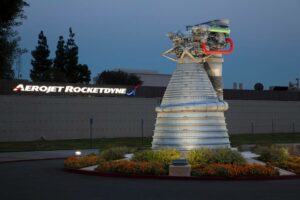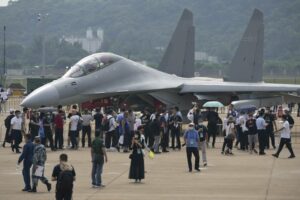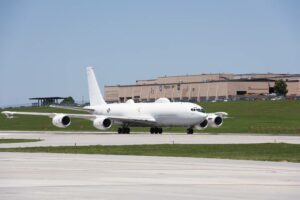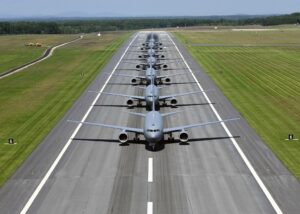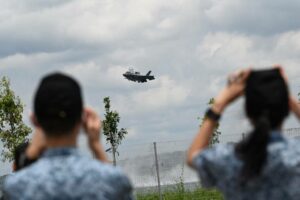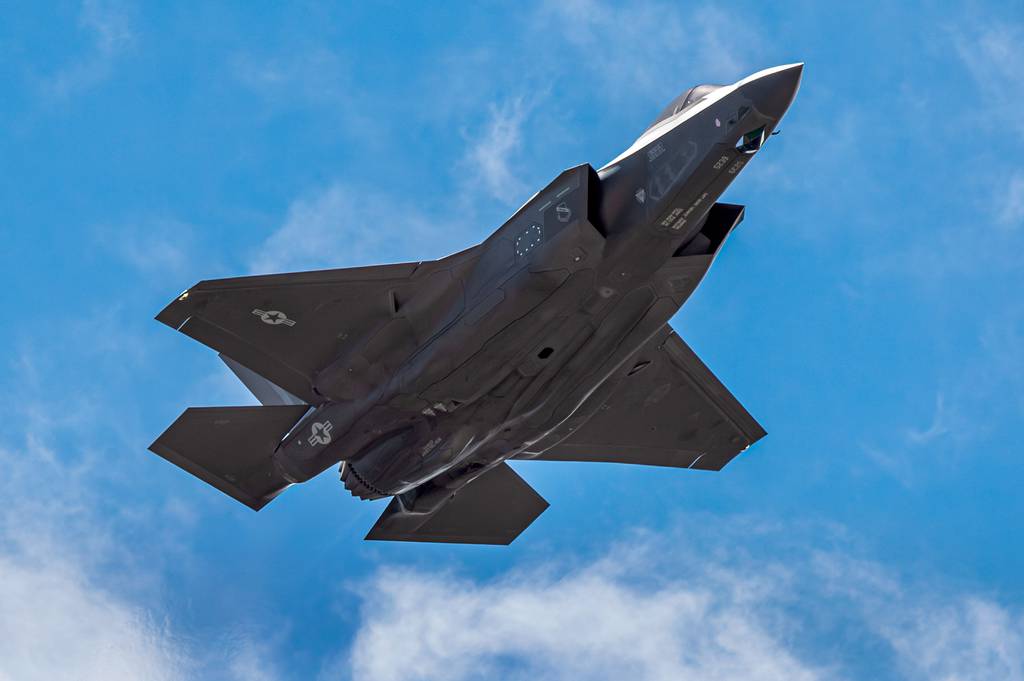
WASHINGTON — The Defense Department will stop accepting some newly built F-35 Joint Strike Fighters beginning next month as delays in upgrading the fighter drag on.
The planned delivery halt of new fighters loaded with Technology Refresh 3 hardware means manufacturer Lockheed Martin may have to store dozens of the planes at its main factory in Fort Worth, Texas, for much of the rest of the year, and perhaps into spring 2024.
The F-35′s Technology Refresh 3 effort — a slate of improvements that aim to give the fighter better displays, computer memory and processing power — was originally due this past April. TR-3 is necessary before the F-35 can receive a more expansive modernization known as Block 4, which will allow the fighter to carry more long-range precision weapons, improve its electronic warfare capability and provide better target recognition.
The TR-3 schedule has slipped considerably, and the F-35 Joint Program Office is now expecting it to arrive no earlier than this December — and perhaps as late as April 2024, a full year behind schedule.
The F-35 Joint Program Office said in a statement to Defense News that the TR-3 delays will in turn disrupt deliveries, causing new fighters to have to be stored in the meantime.
“Starting later this summer, F-35 aircraft coming off the production line with TR-3 hardware will not be accepted until relevant combat capability is validated in accordance with our users’ expectations,” JPO spokesman Russ Goemaere said in an email. “The JPO and Lockheed Martin will ensure these aircraft are safely and securely stored until [acceptance] occurs.”
Breaking Defense first reported the Defense Department’s plan to not accept new F-35s.
Lockheed is now building F-35s with TR-3 hardware installed, and the first such fighter is expected to come off the production line by the end of July, Goemaere said.
The challenge lies in the TR-3 software and getting the programming to work with the new hardware., he said.
In March, F-35 program executive officer Lt. Gen. Michael Schmidt told the House Armed Services subcommittee on tactical air and land forces that the development of TR-3′s hardware had lagged behind and its production started slow, but that it had improved and became reliable.
Software integration, Schmidt said, began late and was proving difficult.
The JPO on Monday said the Defense Department will continue to accept deliveries of fighters with the previous hardware and software known as Technology Refresh 2.
“The government and industry team will continue to work this issue until full resolution is achieved,” Goemaere said.
Lockheed said it remains committed to delivering the first TR-3-enabled F-35 this year.
“Our team is fully dedicated to delivering TR-3 F-35 aircraft and will continue to work with the JPO on software development while maintaining the highest levels of safety and quality,” the company said in a statement to Defense News. “We continue to deliver aircraft in the TR-2 configuration as planned.”
CEO Jim Taiclet this year downplayed the potential for the problems to affect F-35 deliveries. In an April earnings call, after the TR-3 delays were acknowledged to lawmakers, he said the company expected deliveries to be lower than anticipated, but said they would be a “fraction” of total Lockheed’s total deliveries and would have “little to no” effect on the company’s aeronautics revenue.
If the problem is not resolved by the end of the year, perhaps dozens of new F-35s could be undelivered by the end of the year.
Lockheed Martin said in an email to Defense News that it is too early to say how many fighters might be affected, and the company did not say how many F-35s with TR-3 hardware it expects to build this year. The company originally planned to deliver between 147 and 153 total fighters in 2023.
Lockheed on Monday said that it has so far delivered more than 45 F-35s this year, with about 50 more TR-2 F-35s now under construction.
This will be the third time in less than a year that F-35 deliveries have been halted. In September 2022, the Pentagon announced that it had temporarily halted F-35 deliveries after the discovery of a Chinese-sourced alloy had for years been used to make a key magnet in the fighter. Those deliveries resumed in October 2022 after the Pentagon decided the Chinese material did not pose a danger to security or flight safety and issued a waiver.
Pre-delivery acceptance flights were also halted in December, which had the effect of also halting deliveries, due to an engine vibration problem that led to a Dec. 15 mishap involving an F-35B. After a fix was put in place that allowed Lockheed Martin to resume acceptance flights, the Defense Department once again began accepting new F-35s.
In the March hearing, subcommittee chairman Rep. Rob Wittman, R-Va., called the TR-3 delays “unacceptable,” and said it would hurt Air Force squadrons that need the new fighters to replace older, retiring aircraft.
Wittman also quoted an unnamed Air Force official who said of the F-35, “We currently are paying for a great capability, but we’re currently only getting a good capability fielded.”
Stephen Losey is the air warfare reporter for Defense News. He previously covered leadership and personnel issues at Air Force Times, and the Pentagon, special operations and air warfare at Military.com. He has traveled to the Middle East to cover U.S. Air Force operations.
- SEO Powered Content & PR Distribution. Get Amplified Today.
- EVM Finance. Unified Interface for Decentralized Finance. Access Here.
- Quantum Media Group. IR/PR Amplified. Access Here.
- PlatoAiStream. Web3 Data Intelligence. Knowledge Amplified. Access Here.
- Source: https://www.defensenews.com/air/2023/06/12/pentagon-to-halt-upgraded-f-35-deliveries-in-july-amid-software-woes/
- :has
- :is
- :not
- 10
- 15%
- 2022
- 2023
- 2024
- 50
- 70
- a
- About
- Accept
- acceptance
- accepted
- accepting
- accordance
- achieved
- acknowledged
- Aeronautics
- affect
- After
- again
- aim
- AIR
- Air Force
- aircraft
- allow
- Alloy
- also
- Amid
- an
- and
- announced
- Anticipated
- April
- April 2024
- ARE
- armed
- AS
- At
- BE
- became
- been
- before
- began
- Beginning
- behind
- Better
- between
- Block
- build
- Building
- built
- but
- by
- call
- called
- CAN
- carry
- causing
- chairman
- challenge
- chinese
- COM
- combat
- come
- coming
- committed
- company
- Company’s
- computer
- Configuration
- construction
- continue
- could
- cover
- covered
- Currently
- DANGER
- December
- decided
- dedicated
- Defense
- Defense Department
- delays
- deliver
- delivered
- Deliveries
- delivering
- delivery
- Department
- Development
- DID
- difficult
- discovery
- displays
- Disrupt
- dozens
- due
- Earlier
- Early
- Earnings
- earnings call
- East
- effect
- Electronic
- end
- ensure
- executive
- Executive Officer
- expansive
- expectations
- expected
- expecting
- expects
- factory
- far
- fighters
- First
- flight
- Flights
- For
- Force
- Forces
- Fort
- full
- fully
- Gen
- getting
- Give
- good
- Government
- great
- had
- halting
- Hardware
- Have
- he
- hearing
- highest
- House
- How
- HTTPS
- Hurt
- images
- improve
- improved
- improvements
- in
- industry
- integration
- into
- involving
- issue
- Issued
- issues
- IT
- ITS
- Jim
- joint
- jpg
- July
- Key
- known
- Land
- Late
- later
- lawmakers
- Leadership
- Led
- less
- levels
- lies
- Line
- Lockheed Martin
- lower
- Main
- maintaining
- make
- Manufacturer
- many
- March
- Martin
- material
- May..
- means
- meantime
- Memory
- Michael
- Middle
- Middle East
- might
- Military
- modernization
- Monday
- Month
- more
- much
- necessary
- Need
- New
- new hardware
- newly
- news
- next
- no
- now
- october
- of
- off
- Office
- Officer
- official
- older
- on
- once
- only
- Operations
- or
- originally
- our
- past
- paying
- pentagon
- perhaps
- Personnel
- plan
- Planes
- planned
- plato
- Plato Data Intelligence
- PlatoData
- potential
- power
- Precision
- previous
- previously
- Problem
- problems
- processing
- Processing Power
- Production
- Program
- Programming
- provide
- put
- quality
- receive
- recognition
- relevant
- reliable
- remains
- replace
- Reported
- reporter
- Resolution
- resolved
- REST
- resume
- revenue
- rob
- s
- safely
- Safety
- Said
- say
- schedule
- securely
- security
- September
- Services
- Slate
- slow
- So
- so Far
- Software
- software development
- some
- special
- spring
- started
- Statement
- Stop
- store
- stored
- strike
- subcommittee
- such
- summer
- tactical
- Target
- team
- Technology
- texas
- than
- that
- The
- These
- they
- Third
- this
- this year
- those
- time
- times
- to
- too
- Total
- traveled
- TURN
- u.s.
- U.S. Air Force
- under
- UNNAMED
- until
- upgraded
- used
- validated
- was
- Weapons
- were
- which
- while
- WHO
- will
- with
- Work
- worth
- would
- year
- years
- zephyrnet

